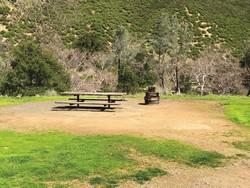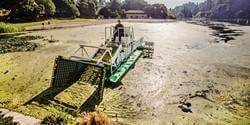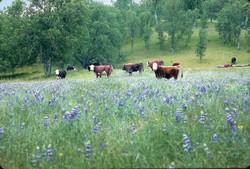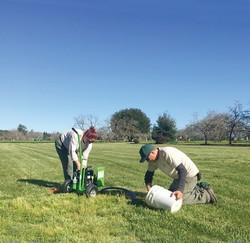Fire Safety | Aquatic Weeds | Noxious Weed Control in Rangelands | Rodents | Insects | Park Hygiene
Fire Safety

To reduce the risk of wildfire, the Park District treats weeds around barbecues and fire pits, along roads and around residences. By prevent weeds from growing large in these areas, the Park District can reduce the amount of herbicide we use. Shifting away from the use of glyphosate-based herbicides, the Park District uses a low-risk pre-emergent herbicide in combination with an organic burndown herbicide. The effectiveness of this approach depends on timing the treatment for when weeds are still very small. Data captured through photo point monitoring and record keeping aids in this adaptive management framework.
Aquatic Weed Control

Overgrown aquatic weeds limit access to fishing, decrease safety for swimmers, and reduces the water flow through aquatic systems. The Park District controls submerged and emergent aquatic weeds using mechanical harvesters.
The Park District, in collaboration with the Alameda County Flood Control District, continues to treat parrot’s feather (Myriophyllum aquaticum), an aquatic weed, at Don Castro Regional Recreation Area. Parrot’s feather is an aquarium escapee that can quickly overtake small reservoirs, depleting dissolved oxygen levels and harming fish and other aquatic organisms.
Preventing the spread of these aquatic weeds and other non-native aquatic organisms, like the quagga and zebra mussels, is critical to maintaining health lakes and waterways. Learn more about the Park District’s Invasive Mussel Program.
Noxious Weed Control in Rangelands

The IPM and Park Operations staff work with the Contra Costa County Dept. of Agriculture to control artichoke thistle (Cynara cardunculus) with a focus on Wildcat Canyon Regional Park. After 25 years the amount of artichoke thistle has been reduced by 95%.
Today, biologists continue to seek out remnant populations and isolated plants throughout the East Bay. Control of artichoke thistle over the last two decades has supported restoration and protection of the Park District’s grasslands, providing habitat for the endangered Santa Cruz tarplant (Holocarpha macradenia) as well as many other native forbs in Wildcat Canyon.
The IPM Unit continues to treat other noxious weeds that threaten rangeland ecosystems including barb goatgrass, medusa head, and yellow star thistle. Barb goatgrass poses a threat since it is capable of colonizing areas previously thought to support only native grasses and forbs – such as vernal pools, serpentine prairies, and oak woodlands. Efforts focus on assessing the extent of these noxious weed populations and ensure a rapid treatment response.
Learn more about the Park District’s grazing program.
Rodent Control

Rodents can be a problem in structures and high-use turf areas where their tunnels can make footing unsafe for visitors. Trapping rodent pests is the preferred control technique because it eliminates non-target damage. We avoid the use of potentially harmful rodenticide wherever possible. For more information about rodent control please visit these county vector control websites:
» Alameda County Vector Control
» Contra Costa Mosquito & Vector Control District
Insect Control
Certain insects can pose health risks for visitors, including ticks, yellow jacket, and mosquitos. Each of these pests can either transmit disease or sting. The Park District actively works to prevent these pests from being an issue during your visit to the parks by mowing the edge of trails to reduce the likely that ticks will jump on you, baiting for yellow jackets, and partnering with county vector control to prevent and reduce mosquito populations. For more information please visit these county vector control websites:
» Alameda County Vector Control
» Contra Costa Mosquito & Vector Control District
Park Hygiene
Plant infection by microscopic water molds, like Phytophthora species, has emerged as a significant threat to many plant species and special communities. In particular, Sudden Oak Death (SOD), which is caused by Phytophthora ramorum, continues to have severe negative impacts on the East Bay’s oak woodlands. Recent studies confirmed that SOD continues to spread within the Park District, changing the age structure of oak forests as younger oaks are less susceptible to this airborne water mold.
The Park District and IPM staff emphasize the role of park hygiene and best practices in limiting the spread of this devastating disease, including cleaning of equipment and preventing the relocation of potentially contaminated vegetation and soils.
The California Oak Mortality Task Force (COMTF) has developed Best Management Practices for many activities and user groups, including a guide for recreational users.
